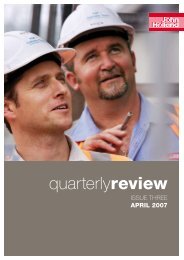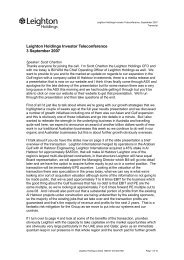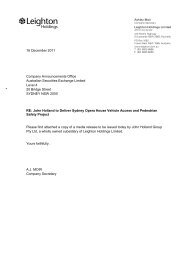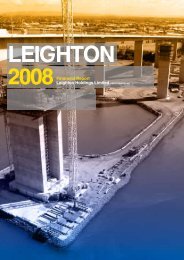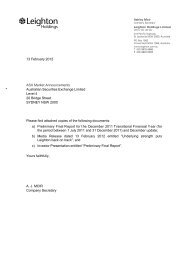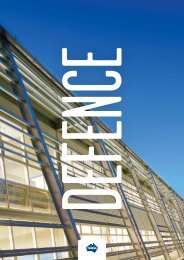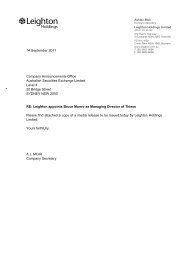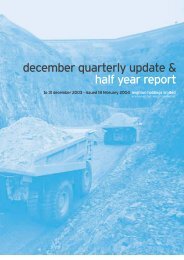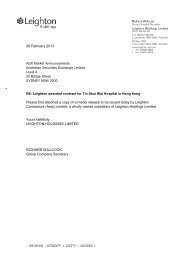preliminary final report & june quarterly update - Leighton Holdings
preliminary final report & june quarterly update - Leighton Holdings
preliminary final report & june quarterly update - Leighton Holdings
You also want an ePaper? Increase the reach of your titles
YUMPU automatically turns print PDFs into web optimized ePapers that Google loves.
construction work done is expected to rise, in real terms, by<br />
20% in 2011 and by a total of 70% over the next three<br />
years, providing a solid pipeline of construction<br />
opportunities.<br />
Australian LNG exports are expected to reach 41 million<br />
tonnes by 2016, underpinned by the completion in 2015 of<br />
projects currently under construction, including the Gorgon<br />
project (15 Mtpa) in Western Australia and Gladstone LNG<br />
(7.8 Mtpa) and Curtis Island LNG (8.5 Mtpa) in<br />
Queensland.<br />
Market Outlook - International<br />
Growth in the global economy is expected to remain above<br />
4% over the next five years through to 2016, underpinned<br />
by strong growth in emerging markets.<br />
The Middle East has returned to pre-GFC long-term growth<br />
levels, while developing Asia continues to outperform the<br />
rest of the world with annual growth of 8.4% expected in<br />
2011 and 2012.<br />
The Middle East and Africa<br />
Despite the recent political unrest in the Middle East,<br />
economic growth is estimated to rebound in 2011 to 4.1%<br />
on average across the region (up from 2% in 2009). A new<br />
era of political and economic freedom could propel the<br />
region forward during the coming decade.<br />
Significant project pipelines in Saudi Arabia, Abu Dhabi<br />
and Qatar support the outlook for robust growth in the<br />
region in the medium term. Favourable demographics –<br />
66% of the Saudi population is under 25 – and energy<br />
sector investments will ensure continued demand for both<br />
social and economic infrastructure. The award of the 2022<br />
FIFA World Cup to Qatar will also increase the level of<br />
available work in the region as that country implements a<br />
US$65 billion infrastructure program.<br />
In Sub-Saharan Africa, recovery has brought output back<br />
to pre-GFC peaks, and many economies have already<br />
moved into an expansion phase. Output for the region is<br />
expected to reach 6% in 2012, reflecting sustained strength<br />
in domestic demand and rising global demand for<br />
commodities.<br />
Africa is a continent rich in mineral resources with, among<br />
others, 60% of the world’s diamonds, 40% of the world’s<br />
phosphate, and 47% of worldwide cobalt reserves. The<br />
region is expected to benefit from the current low interest<br />
rate environment and worries about rising inflation, which<br />
are driving a sustained flow of foreign direct investment into<br />
commodities.<br />
In the latest annual survey of exploration companies,<br />
Botswana overtook Australia as a preferred destination for<br />
new mining investments, achieving a rank of 8 th in the<br />
world. The country has a stable political situation and a well<br />
developed mining sector, backed by a sound regulatory<br />
framework. This signals that a good level of new projects<br />
should emerge in Sub-Saharan Africa in the coming years.<br />
Asia and India<br />
Asia continues to outpace other regions supported by<br />
strong exports, rapid credit growth and robust private<br />
domestic demand. The demand in China and India is<br />
helping other emerging economies as it raises commodity<br />
prices and related investments.<br />
Relatively low levels of government debt and policy<br />
settings to allow higher trend growth have turned the region<br />
into a magnet for foreign capital flows. The outlook for<br />
China – 9.5% growth over the next few years – rests on<br />
continued stability following China’s planned leadership<br />
change in the autumn of 2012. Public debt, currently under<br />
20% of GDP, is estimated to jump to 32% as Beijing cleans<br />
up the provincial governments’ debts. China’s continued<br />
growth should flow on to support other neighbouring<br />
countries.<br />
Hong Kong enjoys a strong fiscal position and the country’s<br />
rapid economic rebound will help push the 2011 budget<br />
surplus to 1.8% of GDP and 3%+ in the following years.<br />
Government spending drove fixed investment through 1Q<br />
2011 and supported 6.8% GDP growth in 2010. Hong Kong<br />
aims to enhance its access to the mainland and last year<br />
launched 10 major infrastructure projects to accomplish<br />
this goal. The value of its construction industry is forecast<br />
to rise from $7.1 billion in 2011 to $9.8 billion in 2015.<br />
Public works spending in Hong Kong drove 2010<br />
construction, but private demand is likely to take over in<br />
2011 as firms and households take advantage of low<br />
borrowing costs. A total spend of HK$67 billion (A$8 billion)<br />
is forecast to be committed from the Capital Works<br />
Reserve Fund on existing and new projects during 2012.<br />
The pipeline of government-funded major infrastructure<br />
projects at 31 March 2012 is expected to increase from<br />
HK$192 billion this year to HK$216 billion and <strong>Leighton</strong><br />
Asia is well placed to take advantage of these<br />
opportunities.<br />
India is expected to remain within recent trend expectations<br />
with GDP growth projected at 7.8% in 2012, driven mainly<br />
by infrastructure spending and corporate investment.<br />
India’s main growth drivers in 2010 – a surge in fixed<br />
investment and strong export performance – are likely to<br />
continue in the medium term as a growing population,<br />
rising rural incomes and urban migration ensure a solid<br />
outlook for 2011 through to 2016. Fixed investment is now<br />
35% of GDP, a level at which it usually starts raising the<br />
long-term productivity of the economy. India is emerging as<br />
a manufacturing centre that is increasingly export driven.<br />
A 20% increase in infrastructure spending is possible over<br />
the next five years, led by strong GDP growth and a step<br />
up in infrastructure investments from 4.6% of GDP to 5.6%<br />
in 2015 (the government’s target is 8%). This is expected<br />
to deliver a wide range of construction and PPP<br />
opportunities, and the newly formed <strong>Leighton</strong> Welspun<br />
Contractors India is anticipating participating in this<br />
investment surge.<br />
Indonesia has outperformed the ASEAN region in terms of<br />
economic growth, which is expected to remain around the<br />
6% level, driven by mild reforms and a lift in fixed<br />
investment. Indonesian sovereign debt is forecast to be<br />
upgraded to investment grade level in the next year, which<br />
will promote further foreign investment in the region. This<br />
will support the level of infrastructure development which is<br />
needed to provide outperforming economic growth.<br />
Indonesia’s coal exports are projected to increase to 340<br />
million tonnes by 2016. Thermal coal production is forecast<br />
to be the fastest growing major source of energy in<br />
Indonesia over the next decade, supported by strong<br />
exports to Asia and rapidly growing domestic consumption.<br />
This is likely to lead to an increase in new mines and<br />
further extensions to existing mining operations.<br />
Mongolia will experience one of the fastest rates of<br />
economic growth in the world over the coming five year<br />
period. However, due to the high level of dependence on<br />
<strong>Leighton</strong> <strong>Holdings</strong> Limited JUNE 2011 QUARTERLY UPDATE Page 40



